 THIS IS WHAT WE’LL DO:
THIS IS WHAT WE’LL DO:
TALK ABOUT BOOKS, OBJECTS, AUTHORS, ARTISTS, TRAVELS AND EVENTS.
WE ARE LUCKY TO DO WHAT WE DO AND FIND SOME ASTONISHING THINGS ALONG THE WAY.
COMMENTS ARE INVITED AND APPRECIATED.
HERE GOES…
 THIS IS WHAT WE’LL DO:
THIS IS WHAT WE’LL DO:
TALK ABOUT BOOKS, OBJECTS, AUTHORS, ARTISTS, TRAVELS AND EVENTS.
WE ARE LUCKY TO DO WHAT WE DO AND FIND SOME ASTONISHING THINGS ALONG THE WAY.
COMMENTS ARE INVITED AND APPRECIATED.
HERE GOES…
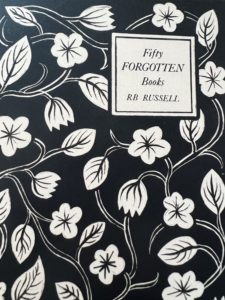 We are delighted to host the author and Tartarus Press co-founder R.B. Russell and the South Yorkshire press ‘And Other Stories’ for the launch of Fifty Forgotten Books, in which the author takes us on a guided tour through the wonderful, macabre and obscure books that make up his legendary collection – and the sadly vanishing breed of second-hand booksellers from whom he acquired them.
We are delighted to host the author and Tartarus Press co-founder R.B. Russell and the South Yorkshire press ‘And Other Stories’ for the launch of Fifty Forgotten Books, in which the author takes us on a guided tour through the wonderful, macabre and obscure books that make up his legendary collection – and the sadly vanishing breed of second-hand booksellers from whom he acquired them.
Join us on the 29th September at 6:30pm to celebrate the publication of this wonderfully warm love letter to a literary life well-lived and a rich exploration of forgotten histories of book-collecting and selling in Britain.
The event will feature short readings from R.B. Russell and his Tartarus Press co-publisher Rosalie Parker, followed by a chance for discussion and of course the opportunity to purchase a signed first edition of the book. Refreshments will be provided. Tickets are free, but limited so please go ahead and book at your earliest convenience. BOOK HERE
We look forward to seeing you!

Eskimaux and English Vocabulary, for the Use of the Arctic Expedition (London: John Murray, 1850).
At first glance an unassuming little book bound in simple black cloth, the unexpected title – “Eskimaux Vocabulary / For the Use of the Arctic Expedition” – boldly printed in gilt to the front cover, quickly catches the eye and the imagination.
Published in London in 1850, it was designed as a field guide to Inuit languages for European Arctic explorers, enabling the translation of useful phrases back and forth between English and what it defines as three categories of native dialect: “Labrador, or Eastern”, “Winter Island and Iglúlik, or Central”, and “Kotzebue Sound, or Western”.
In introducing the guide, its author, John Washington (1800-1863), a Royal Navy officer and founding member of the Royal Geographical Society of London, describes the Inuit languages as “graceful and energetic”, praising the “strength and brevity” of expression which resulted from their tendency to blend multiple words. He also notes how they “abound in words expressive of common objects”, for example animals, the natural landscape and weather, through which they can distinguish “slight shades of difference” via the use of specific terms.
Despite, however, the clichéd claim that Eskimos have more than fifty different words for ‘snow’, this guide offers only a couple. Indeed, its focus was essentially practical, aiming to condense previous tomes – “of little use…for the daily requirements of parties…in boats or on land expeditions” – into a handy pocket guide, furnishing “every officer and leading man in the Arctic expeditions with a book of ready reference that he can carry in his pocket without inconvenience”.
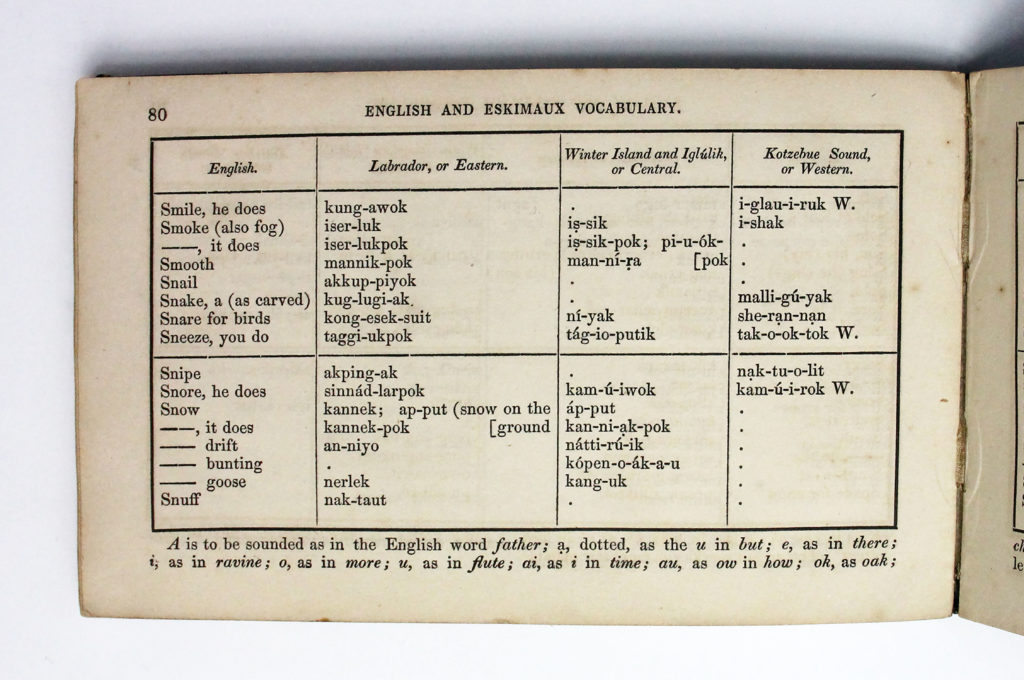
A typical page from the Vocabulary, showing the entry for ‘snow’.
In addition to translating many hundreds of key words, the guide contains several specimen dialogues with titles including “On first meeting with natives” and “Dialogue with a sick man”. Through these, an explorer could learn how to translate phrases such as “I want to buy twelve good dogs”, “We are going to travel over the ice / Will you go with us as a guide?”, and “Do you catch many seals? / Show us how you catch them”. It also includes tips on conversing with Inuit peoples, noting how they “make much use of winks and nods”, as well as awkwardly advising perhaps usually reserved British naval officers that in “close quarters rubbing noses is the most approved mode of salutation”.
The central purpose of the guide was, however, even more particular than simply assisting Arctic exploration – it was created with the explicit aim of aiding one of the most famous rescue missions of the nineteenth century.
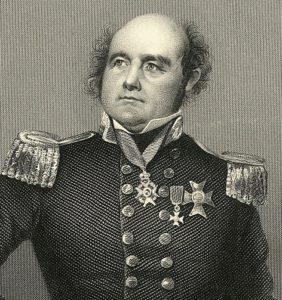
Sir John Franklin
In May 1845, Sir John Franklin, a renowned explorer and veteran of three previous Arctic expeditions, set out with two ships and 134 crew to map the last unnavigated section of the Northwest Passage through northern Canada. On 26th July they were sighted for the final time by a European vessel in Baffin Bay. Two years then passed with no word from the expedition, leading Franklin’s wife, Lady Jane Franklin, to repeatedly urge the British government to send a search party. After a third year elapsed, and with the expedition only carrying provisions for that length of time, the Admiralty finally agreed, offering a staggering £20,000 reward for locating Franklin and his men. The size of the reward (about £1.6 million today) and Franklin’s fame led to widespread public interest and numerous expeditions, with the search becoming something of a national crusade.
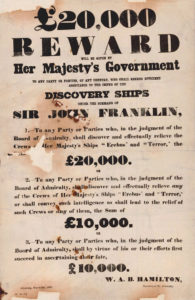
Poster offering a reward for help in finding Franklin’s lost expedition.
Washington hoped that his Vocabulary – “compiled for the use of the Arctic Expeditions fitted out at the expense of the British Government to carry relief to Sir John Franklin and his companions” – would aid in bringing “the joyful intelligence” of their safety. He was encouraged in this thought by previous expeditions which had experienced much helpful “intercourse…with the natives of the north-western coast”. He thus included in his guide specific lines to be recited to any Inuit encountered: “We are in search of two English ships / Which have been five years in the ice / Have you heard anything of such ships? / Make it known among all the Eskimos or Innuit / That the Queen of England will give a large reward / To any of the Innuit who will bring news of them”.
It certainly appears that the guide was actively used in the search for Franklin. Peter Sutherland, a member of two such expeditions during 1850-51, gave it a notable mention, declaring that only through using that “excellent vocabulary”, had they managed to make themselves “tolerably well understood” (albeit still complaining that the replies they received were “too hastily made, and far too voluminous to be comprehended”).
Washington’s motivations were indeed ultimately vindicated when, in 1854, it was through conversing with Inuit hunters that the Scottish explorer John Rae became the first to learn of the Franklin expedition’s fate – how both ships had become icebound, and how the men, after attempting to reach safety on foot, had succumbed to cold, with some even resorting to cannibalism.
Whether Rae himself used Washington’s Vocabulary at any point is unknown. Nevertheless, this compact field guide, designed for easing the interaction of two alien cultures, would have been an essential piece of kit, stuffed into the bags of many nineteenth-century polar explorers. With such a specific purpose, few copies would have originally been printed, and most that were have not endured what would have likely been a rough-and-ready life, making this copy a genuinely rare survivor and a fascinating piece of Arctic history.
Andre Norton (born Alice Mary Norton in Ohio in 1912) was a hugely prolific writer and one of the earliest women to achieve widespread success in the traditionally male dominated genres of science fiction and fantasy.
Norton’s earliest books were historical adventures for young adults (which would have been described as ‘juvenile fiction’ at the time) published in the 30s and 40s. She legally changed her name to the androgynous Andre in the same year that her first book was published under the advice of her publisher, as it was thought that boys would not read a book written by a woman. Speaking in 1982 on this decision, she said that as “a woman in a man’s field” and with so few women were working in genre fiction “we had to”. In a 1985 interview Norton even recalls how she refrained from writing about female characters until Ordeal in Otherwhere in 1964, and that even then her publisher was “most dubious” about the book’s appeal.
In reality, as well as garnering a dedicated general readership, Norton ended up attracting many new female readers to science fiction and fantasy. Many of these such as Mercedes Lackey, Judith Tarr, Sherwood Smith, Martha Wells, and Susan Shwartz then went on to become a part of the next generation of writers in the genre themselves, often citing her as a role model or speaking of a particular, special respect they held for her. Though always modest about her role in bringing more women to the genre, Norton often went out of her way to publicly recommend books by new female writers, frequently collaborated with other women, and created a prize in 1989 called the Gryphon Award, specifically for new books by women writers.
Although Norton’s books, like any product of a specific time, certainly contain stereotypes and concepts that now appear outdated, her casts of characters are much more diverse and varied than their average contemporary’s, and the essential message of her work is that it’s ok to be different, and that equality and respect between all beings is of the greatest importance. Star Guard, for example, is described as ‘subversive’ by Judith Tarr, particularly for the 1950s. Featuring characters with a diverse range of ethnic backgrounds, this post-nuclear-war, interplanetary science fiction is underpinned by a careful exploration of colonialism.
Norton was herself an avid book collector, and it became a passion project of hers to create a research library of rare and fascinating books and artefacts pertaining to science fiction, fantasy, legends, ancient history, gothic, and the occult. She briefly achieved her dream towards the end of her life with “High Hallack Library” in Tennessee, which housed over 10,000 texts and was complete with guest rooms and on-sight facilities so that scholars and writers could completely immerse themselves in their research.
Norton died at age 93 in 2005, and left behind an unmistakeable mark on the world of science fiction and fantasy. She was honoured with the Science Fiction and Fantasy Writers of America‘s Grand Master Award in 1984, and with the World Fantasy Award for lifetime achievement in 1998; and has been commonly referred to as Grande Dame of Science Fiction and Fantasy by publications such as Publisher’s Weekly and Time magazine, biographers, and her fans; but moreover her hundreds of books were read by many generations of readers across a period when the genre was still in its formative state: she had already been a published author for 10 years when J. R. R Tolkien’s The Fellowship of the Ring was published in 1954, and her blend of sword and sorcery fantasy themes with outer space science fiction settings, typified in books like Star Gate, became her trademark long before the same combination became so familiar in the Star Wars franchise.
Find our collection of UK first edition Andre Nortons here.
Painter and illustrator Millicent Sowerby was born in 1878 in Gateshead to a wealthy glass-making family. Her father, John G. Sowerby, as well as acting as director of the glass-making factory, also enjoyed recognition as a painter and illustrator. Millicent was one of the first women to illustrate Lewis Carroll’s Alice in Wonderland, and she also illustrated children’s books by her sister Githa.
Millicent moved to London with Githa in the early 1900s, and the pair began work on their books, Githa writing them and Millicent illustrating them. We at Lucius Books are fortunate enough to have acquired seven beautiful, original illustrations for one such book, Childhood, the sisters’ second book, a collection of children’s verse published in 1907.
Githa also wrote plays, and her most famous, the deeply political play Rutherford & Son (written under the deliberately genderless name of K. G. Sowerby) became a critically acclaimed sensation in London and was subsequently performed in New York. The eventual discovery that the play was written by a woman was met with shock and disbelief, and even withdrawals of praise by some critics. Sadly, the play eventually fell into obscurity before its slow but steady revival in the 1980s, and there is now a growing interest in Githa’s life and work as northern-born, political, feminist thinker and writer.
Millicent’s style was strongly influenced by Kate Greenaway, and her idyllic scenes of sweetly dressed children and tranquil domestic life fitted perfectly into the popular genre of Edwardian children’s gift books. The illustrations for Childhood are highly worked with a very fine attention to detail and an accomplished command of colour. Millicent is adept at creating smoothly blended planes of colour on a dress or a face that contrast against more textured areas built up with tiny brushstrokes to indicate hair, grass, or rough wood. A favourite of mine shows a domestic scene in which a mother works on embroidery whilst glancing affectionately at her child who is writing with a quill. The skilful diagonally trailing composition which flows from the child’s feet up to the top of the mother’s head and the subtle use of muted colours create a harmonious, tranquil picture.
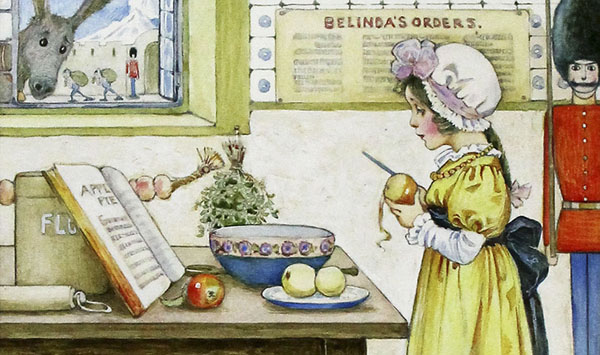
A detail of ‘Apple Pie’, from Childhood.

‘His Book’ and ‘In Church’, from Childhood.
Find our Sowerby illustrations here.

Annie French’s letters to Violet Neith
Over the last few days I have had the pleasure of researching and cataloguing a collection of decorated letters, calendars, and bookmarks created by the “Glasgow Girl” and contemporary of Jessie M. King, Annie French, which has been a lovely task while working from home! Annie French (born 1872) is something of an elusive figure and little is recorded of her life, which makes these letters and keepsakes that she made for a close friend very special.
The calendars and letters are decorated with tiny detailed borders and flowers which have a certain looseness of style that lends them a frothy romanticism. French also often adds profuse collections of her favourite quotations in beautiful lettering. The colourful bookmarks are covered in colourful flowers, and one of them bears the image of an enchanting young woman with long hair and a flowing green gown.
The letters and gifts date between 1939 and 1954, each sent as “New Year Greetings”. The recipient is Violet Neith (née Anderson) of the artistic Anderson family. Violet’s mother and father, Daisy Agnes McGlashan and William Smith Anderson, met at the Glasgow School of Art, and attended the school at the same time as Annie French, which is likely to be how the families became friends. Violet and her sister Daisy (in the letters French affectionately enquires after “the Daisies”, clearly referring to Violet’s mother and sister) also attended the school in the 1920s. French also mentions handmade art and gifts that she had received herself from Violet, Violet’s artist husband John Neith, as well as more of their friends and family; you really get a sense of the creative energy in the social and family groups that were affiliated with the “Glasgow School”, even decades after the movement’s greatest peak in fame and success.
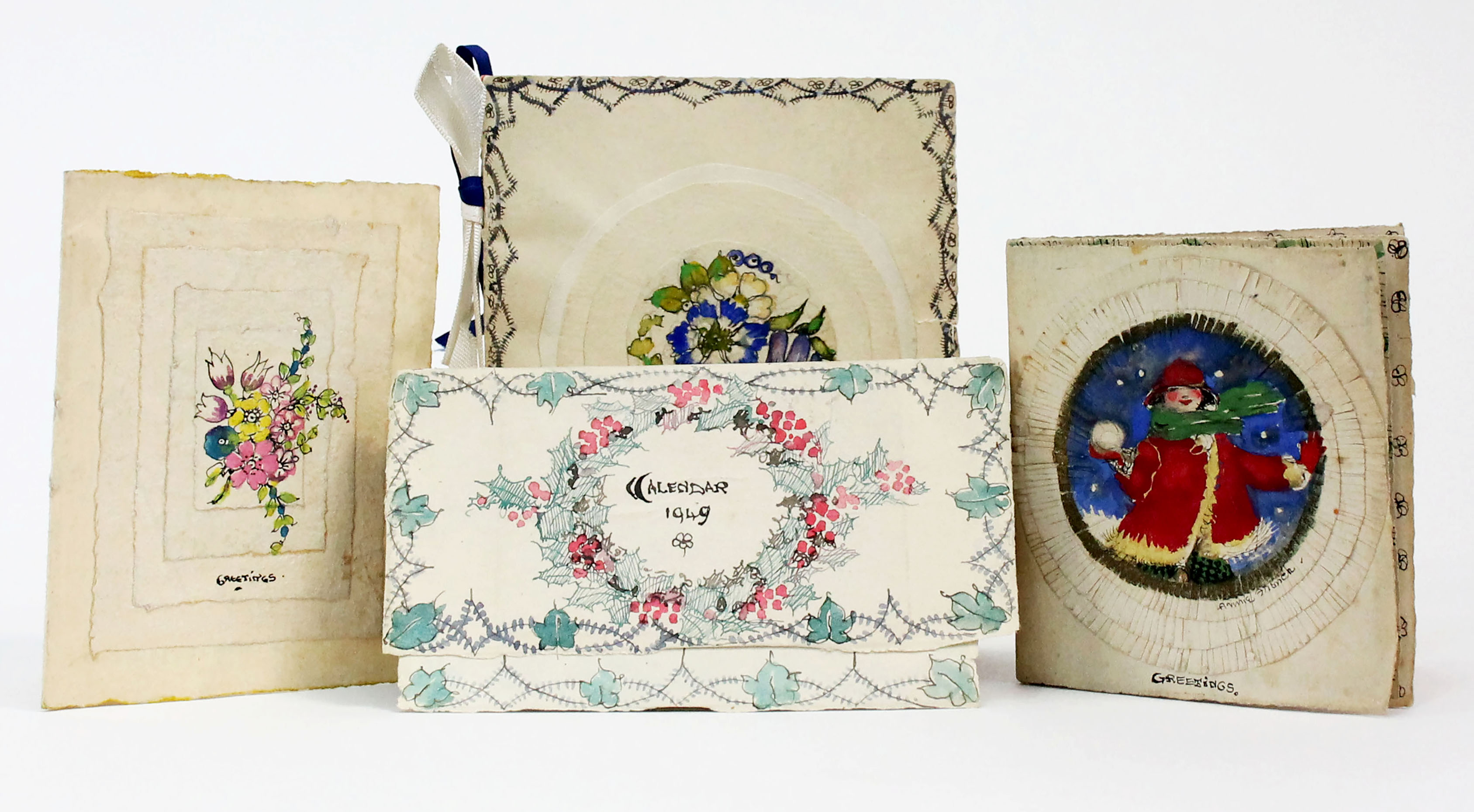
Calendars made by Annie French
It is difficult to build a complete picture of French’s life. Much of what is known is owed to the research of the art dealer Una Rota, who was unfortunately unable to complete her planned biography of French due to ill health in her later years. Much of Rota’s research consists of correspondence with people who knew French, leading more to a picture of her as a person rather than the historical structure of her life events. One lovely quote from a friend of French describes her as “like thistle down, she was small, dainty and merry”. It is believed that French, in something of an artistic tradition, destroyed many of her own papers at the end of her life (in one of the letters, French describes returning gifts given to her by her friends to them, for fear of their artwork being snatched into the unknown in the event of her own death), so it is wonderful to see these letters which have clearly been carefully cherished for many years by Violet Neith. The letters mostly detail small comments on and descriptions of everyday life, but French’s creative and adept use of language make them a compelling read, with metaphors like “butterfly” people, and not caring for a life that is a “stream that tumbled along among boulders”.
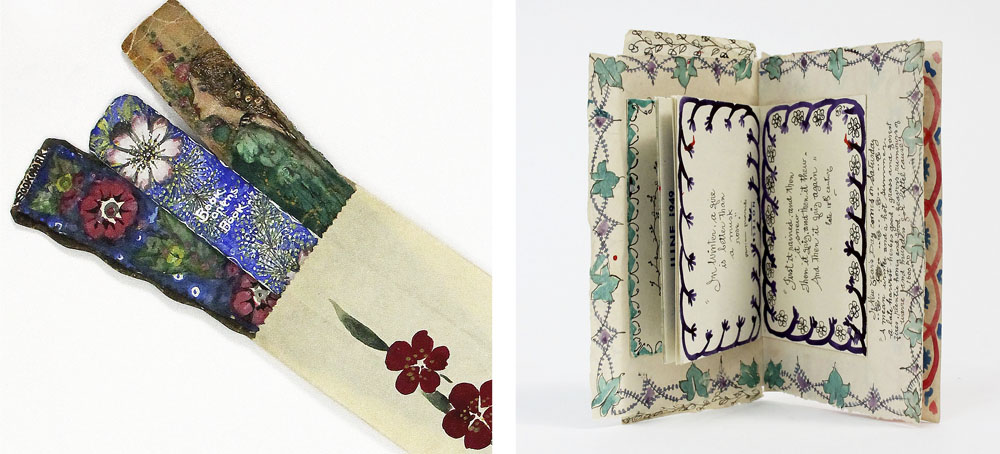
The bookmarks in their decorated envelope and the inside of one of the calendars
After her studies, French returned to The Glasgow School of Art as a teacher, before marrying a fellow artist, George Woolliscroft Rhead, with whom she moved to London in 1914. Some time after George’s death in 1920 French moved to “1 Oaklands” in Kenley, Surrey, where she lived, seemingly across two flats, with two of her sisters, Agnes and Margaret, and this is where this collection was created. Agnes died in 1952, and Margaret suffered an unnamed accident from which she unfortunately never recovered, dying in 1954. There are various points in the letters in which French describes finding life difficult, and it is surely these events to which she refers. It has previously been suggested that French then moved to Jersey to live near to relatives as a reaction to both sisters’ deaths, but these letters reveal that Annie and Margaret were both planning on the move: French describes trying to get her affairs and belongings in order, and says that Margaret will need to recover before the move.
French did eventually move to Jersey to be close to her sister-in-law and beloved nephew Eric, who enjoyed painting with his aunt, and whose recollections of her form some of the most intimate components of Rota’s research. French died in Jersey in 1965 at the grand age of 92. These beautiful gifts and letters offer a remarkable and truly unique look into the work and life of a private, and in my opinion unfortunately overlooked, artist, as well as a small snippet of the wider, vibrant world of the Glasgow School, which so influentially shaped British decorative arts at the birth of the 20th century.

Enid Blyton’s Claudine at St. Claire’s
“Girls! Girls everywhere! Girls in the passages, girls in the hall, racing upstairs and scurrying downstairs, diving into dormitories and running into classrooms, overflowing on to the landing and hustling along the corridor — everywhere, girls! There were tall and short, and fat and thin, and all degrees from pretty to plain; girls with fair hair and girls with dark hair, blue-eyed, brown-eyed, and grey-eyed girls; demure girls, romping girls, clever girls, stupid girls — but never a silent girl.”
(Angela Brazil, The School by the Sea)
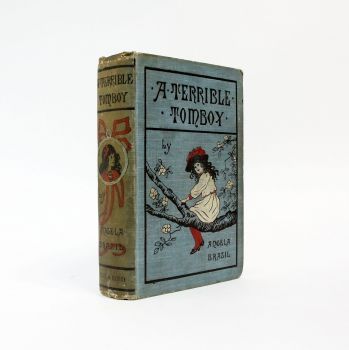
An early, signed Brazil novel, A Terrible Tomboy. Though not strictly a school story, it is semi-autobiographical and features school elements.
The genre and formula of the girls’ school story is a familiar, well loved one, still read by all ages and exerting a strong influence on modern writing today. Its history can be traced all the way back to the 1700s and Sarah Fielding’s The Governess, or The Little Female Academy, which is not only credited as the first school story, but also as the first full length novel for children. This is particularly remarkable as books aimed at girls were especially unusual at the time. The Governess sees its school’s nine pupils tell their own life stories, read together, and learn moral lessons and good behaviour, which is the ultimate theme and aim of the book.
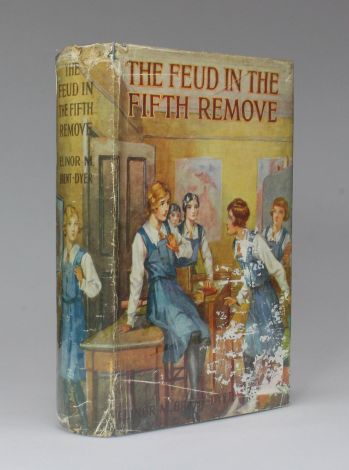
The Feud in the Fifth Remove, an early Brent-Dyer standalone school story.
This emphasis on instructive, moralistic, often religious tales in girls’ school stories (which surged in popularity in the late 1800s) was de rigueur until the early 20th century when Angela Brazil, the original pioneer of the modern incarnation of boarding school fiction, arrived on the scene. While Brazil’s work may seem tame or stuffy or simply a jolly-hockeysticks cliché to today’s average reader, in her time it was somewhat groundbreaking and even rebellious. Some people of a more conservative leaning even condemned them as dangerously subversive, and there are accounts of headmistresses banning the books outright. The stories served primarily as entertainment rather than as moral instruction, and the multifaceted, sporty young female characters (usually aged around 14 to 15) weren’t unfamiliar with a bit of trouble, pranks, and flouting of authority; even their vocabulary, which seems quaint today, was full of contemporary, indecorous, youth-led slang.
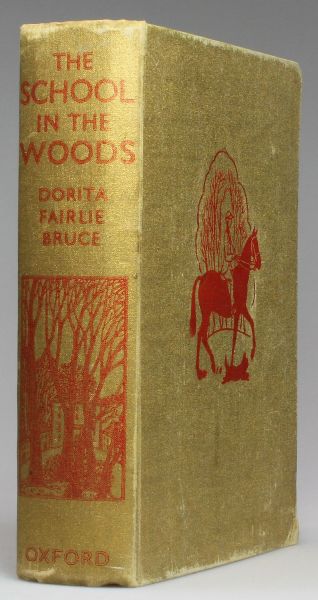
The School in the Woods by Dorita Fairlie Bruce.
Following closely after Brazil were Dorita Fairlie Bruce, famous for her Dimsie series; Elinor Brent-Dyer with the hugely popular Chalet School series; and Elsie J. Oxenham with her slightly more Christianity-influenced The Abbey Girls series; with Enid Blyton carrying the popularity of the school story into and past the mid-20th century with Mallory Towers and St. Clare’s. All of these authors use the school setting (the schools and lessons themselves hold varying levels of importance from series to series) as a way of giving the young female characters stardom and autonomy within the novels. They create an almost mythical world, largely free from adults and populated and driven by girls; their structured, insular societies within a society held together by female friendships and relationships simultaneously provide freedom and adventure and safety and security.
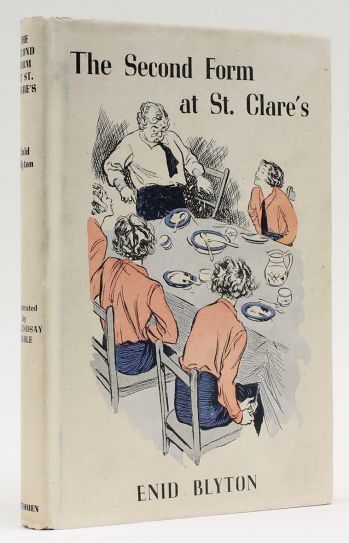
The Second Form at St. Clare’s by Enid Blyton.
For these reasons the boarding school setting has appealed even to authors that write outside of the classic school story formula, particularly as a way to frame and facilitate the trials of adolescence and the hypnagogia of emergent adulthood. An early example is Frances Hodgeson Burnett’s A Little Princess, in which Sarah Crewe and her friends experience upheavals and hardships but ultimately emerge as improved and well-adjusted individuals together within the community of a girls’ school. The otherworldly, isolated image of the boarding school has also lent itself to surreal, supernatural additions in later decades, such as Penelope Farmer’s Charlotte Sometimes, a dreamy time travel novel that sees a 1970s schoolgirl swap places back and forth overnight with a former pupil whom her bed belonged to in 1918, or the gothic The Moth Diaries published in 2002 which, although thematically the near antithesis of the earliest school stories, uses the same boarding school world-structure of insular adolescent female freedom to deal with obsession and sexuality along with implied vampirism.
As each wave of boarding school books influences the following generation of writers, the genre adapts and continues: the most notable modern jump-starter of course being J. K. Rowling with the co-educational magical boarding school Hogwarts, but the setting has also attracted authors like Jacqueline Wilson and John Green, showing that the near-imaginary, child-ruled world provides the perfect backdrop for stories that are funny or serious, sexy or staid, realistic or fantastical, and captures readers with a nostalgic but ever-adapting, enduring appeal.
At times like these when the world can seem like a dark, confusing place, it becomes important to find a little joy here and there so that we can keep on going. Something that has personally lifted my spirits recently is a little gem of a book that my colleague Sky brought back from the California Book Fair shortly before book fairs started to get cancelled. It is a “Chap Record”, a form of journal designed specially for a lady to keep organised notes on all of the men she meets; a concept summarised wonderfully by the snappy verse printed on its opening pages:
“Behold herein, all nice and neat,
A record of the men I meet.
Among them all perhaps, there be –
Who knows? – the ‘not impossible’ He.”
Each entry has space for the man’s name, the date and place, and the lady’s opinion on him. This particular Chap Record belonged to Gertrude L. Beebe (born in 1893 in Brooklyn) who started writing in it in 1910 when she was around 17 and kept doing so until 1917 when she was around 24. Gertrude rather prolifically filled in 55 single sided pages and recorded a whopping 162 men, many of whom she met at a huge variety of parties and holidays (such as a “Japanese Party at Helen Francis’” and “Addis Wilmot’s Halloween Party”) across Brooklyn, Newark, and Baltimore to name just a few.
It soon becomes clear which particular attributes Gertrude was paying attention to in a man, with her always commenting on their height; almost always noting whether they were dark or fair; and often noting if they were ‘jolly’, ‘good fun’, ‘quiet’, or ‘lively’; as well as commenting on their dancing and piano playing prowess. She seemed to have a particular soft spot for a handsome pair of eyes and an attractive voice, with those that she found pleasing earning the description of ‘dandy’. She didn’t tend to dwell too long on the men she she didn’t like, instead signing their entries off with the almost quality-control-style repetition of “nothing to rave about”, though she clearly took a particular dislike to a man known only as “-?” who Gertrude states was:
“Short – not very good looking – horrid. Only saw him for five minutes.”

It seems that she marked her favorite men with a little “C” symbol in the corner of their entries, as with Carl Smith’s entry, which reads:
“Perfectly stunning chap. Tall and very dark with beautiful eyes. Rather quiet and dances dandy. Quite an independent chap.”
In 1916-17, though, she dropped this method, and instead took to the after-note: “I am terribly fond of… [lucky man’s name here]”. One of the last few entries, one Fred Fraser, is even lauded as “a peach of a fellow”. The volume is a truly wonderful record of a wealthy young woman’s social life in early 20th century New York and beyond, and is an absorbing read in itself, the short notes revealing much more about its unexpectedly relatable writer than its subjects. I couldn’t help but smile and laugh as I made my way through the 162 entries, transported for a few moments to another time and another world.

The journal is happily accompanied by two photographs of the society beauty, which seem to radiate with happiness and vitality. One is a glamorous headshot, the other a photograph of Gertrude in a surprisingly fashionable fancy dress owl costume, possibly at Addis Wilmot’s aforementioned Halloween party.
This fascinating journal is, considering its age and how long Gertrude kept it for, in excellent condition, and provides an incredible historical glance atromance and dating, as well as being a very welcome, uplifting, and resoundingly humorous diversion. Unfortunately we have not been able to find out what happened to Gertrude or if she ever married, but I like to imagine that the reason she stopped writing in 1917 is that she did eventually find her “‘not impossible’ He”.